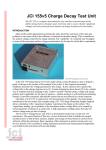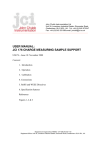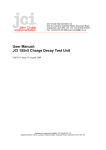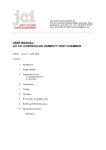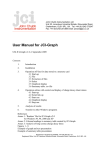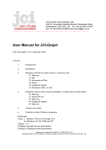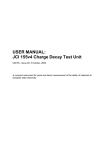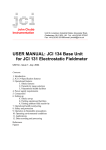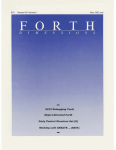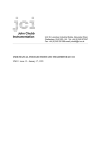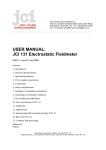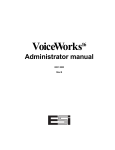Download User Manual:
Transcript
JCI 155v5 Charge Decay Test Unit The JCI 155 is a compact instrument for easy and direct measurement of the ability of materials to dissipate static electricity and to assess whether significant voltages will arise from practical amounts of charge transferred to the surface. INTRODUCTION Many of the useful opportunities presented by static electricity and many of the risks and problems it can cause relate to the influence of retained electrostatic charge. This is manifest as the surface voltage created by the charge retained. The ‘suitability’ of a material may be judged in terms of the maximum surface voltage created and/or by the time for which this is maintained. JCI 155v5 Charge Decay Test Unit In the JCI 155 Charge Decay Test Unit a high voltage corona discharge is used to deposit a patch of charge on the surface of the material to be tested. A fast response electrostatic fieldmeter measures the voltage generated by this charge. It also measures how quickly this voltage falls as the charge migrates away [1]. Corona charging has been shown [2] to be a simple way to simulate practical charging events. It allows control of initial surface voltage and charge polarity and is applicable for all types of surfaces - whether uniform or with localised conducting features. It provides consistent, reproducible results that are not affected by corona exposure. Operation of a JCI 155 in conjunction with measurement of the quantity of corona charge transferred to the test surface (for example using a JCI 176 Charge Measuring Sample Support) allows calculation of the ‘capacitance loading’ experienced by charge on the surface. This ‘capacitance loading’ gives guidance to the maximum surface voltage likely to be created by certain quantities of charge on a surface [4]. A high capacitance loading means that only low surface voltage arise per unit of charge. The JCI 155v5 Charge Decay Test Unit is a development of previous version JCI 155 instruments. The special feature of this new version instrument is that it includes an integral microprocessor so that all basic analysis, display and storage of observations is carried out by software within the instrument. Basic operation of the instrument is achieved using only very few key buttons. Full versatility in setting instrument operation and measurement arrangements is provided by the instrument software and display and associated software JCI-Graph. INSTRUMENT OPERATIONAL FEATURES Test Area: The JCI 155 has a 45x54mm test aperture in the instrument baseplate. This can rest directly on the test surface. Contact with the surface around the test aperture provides a return route for outwardly migrating charge and high local capacitance to trap such charge. With short duration corona charging (e.g.20ms) the presence and position of the outer earth boundary is not important. Measurements can be made on surfaces smaller than the test aperture area. Charging: The surface is charged by a high voltage corona discharge (3-10kV) from the tips of a small conical cluster of fine wires mounted on the underside of a light moveable plate. This plate is moved between the fieldmeter sensing aperture and the material surface exposed through the instrument baseplate. Corona is usually generated as a brief pulse (20ms) immediately before the plate is moved away. The plate moves fully away within 20ms. The moving plate and instrument construction shield the fieldmeter from high voltage connections so reliable measurements can be made down to even quite low surface voltages. An ‘air dam’ is included on the trailing edge of the moving plate. This sweeps away residual air ionisation at the end of the corona period to give a so there is little influence on surface voltage measurements (no more than about 10V). Fieldmeter: A proprietary fast response 'field mill' electrostatic fieldmeter [5,6] gives fast, sensitive and stable measurement of surface potential. The response time is below 10ms and charge decay times can be measured from below 50ms to many days. Fieldmeter seen through test aperture Instrument software provides for automatic zero setting of the fieldmeter just before each test. In very long charge decay studies arrangements are made to check the fieldmeter zero from time to time. It is not easy to measure decay times with signals where noise is significant in comparison to the signals or the signal differences to be measured. This may apply for materials that dissipate charge either so quickly that the initial peak voltage is very low, only 10-50V, or with materials that dissipate charge very slowly, so that small differences in signal levels need to be measured to get results within modest periods of observation. A special feature of the JCI 155v5 is that it uses a new ‘stutter timing’ approach for decay timing. This provides an excellent way to identify average values of a noisy signal without slowing down time response. Sample support: Measurements are normally made both with the material freely supported with an open backing and also resting against an earthed backing surface. These two arrangements represent the extremes of constraints of practical application. The longer of the two decay times is used for assessment of the suitability of the material. The JCI 166 Sample Support provides a simple arrangement for such measurements. Simultaneous measurement of the quantity of charge received by the sample surface and the initial peak surface voltage achieved enables calculation of the ‘capacitance loading’ experienced by charge on the sample surface [3,4,7,8]. The JCI 176 Charge Measuring Sample support provides the ability to measure the corona charge received by the sample. This unit can be directly connected to the JCI 155v5 (by an 8w-8w DIN cable) so that charge measurements are stored alongside the relevant charge decay observations. Measurements using the JCI 176 can be with both open and earthed backing. JCI 155v5 on JCI 176 Charge Measuring Sample Support Powder samples may be presented using the JCI 170 Powder Sample Support with the JCI 155v5 supported by a JCI 172 Support Plate so the JCI 170 can be easily put in place an removed and so that the baseplate of the JCI 155v5 is stood off a few mm to reduce risk of powder dispersal into the air by action of the air dam. Powder, and liquid, samples can alternatively be presented for testing using a JCI 173 Powder Sample Support Plate mounted between the plates of a JCI 176 sample support. Test conditions: Charge decay characteristics are usually susceptible to absorption of surface moisture from the atmosphere, so measurements are very likely to depend on humidity. It is hence desirable to carry out testing under defined, or at least known, conditions of temperature and humidity. This can be achieved by carrying out measurements in a controlled environment – as is provided, for example, in the JCI 191 Controlled Humidity Test Chamber, with adequate time allowed for acclimatisation. The JCI 155v5 includes facilities to measure both temperature and humidity within the test region of the instrument. These measurements are stored along with all the other information on test conditions. JCI-Graph: All test conditions and observations are stored to a memory card slotted into the JCI 155v5. This data can be transferred to a PC using proprietary Windows software JCI-Graph. This provides opportunity to display up to 4 graphs at a time of observations and to transfer these together with associated numerical test and result information into wordprocessed documents. A summary table of test and result information is also created. Opportunity for on-line operation. Test criterion: A simple acceptance test criterion is that the decay time (initial peak voltage to 1/e (37%) of this) should be less than half a second. Experience is that the form of charge decay curves is usually not an exponential. The form of the curve however does not usually depend on the level of the initial peak voltage or, hence, on the level of charging. Thus a ‘decay time’ measured as a set percentage of the initial peak voltage is an appropriate basis by which to rate materials. A point immediately after the initial peak voltage is used as a starting point for timing as timing from this point includes as much information as possible about possibly fast initial voltage drops. The point is chosen to be immediately after completion of competition between opening of the moving plate and the decay of surface potential. It is also useful to record how the rate of charge decay varies during decay to see whether significant levels of charge may be retained for long times. It is observed that charge decay curves may ‘plateau out’ after an initial perhaps fairly rapid fall of surface voltage. In this situation it may be argued that a better acceptance test criterion would be the time to 10% of the initial peak voltage – as this would better ensure that residual surface voltages were low. Measurements to both 1/e and to 10% are recommended when practicable. Measurement of the quantity of charge transferred to the sample and the initial peak voltage enables materials to also be assessed in terms of ‘capacitance loading’. Decay timing: Decay times are measured using a proprietary technique called ‘stutter timing’. This approach very effectively overcomes problems with signal noise at low signal levels. It is helpful a) with very slow charge decay rates, and b) with very low initial peak voltages (for example 10-50V). Stutter timing works by running and stopping the timing clock according to whether the instantaneous fieldmeter signal is above or below the voltage level of interest. This approach is used both in the algorithm for finding an initial peak surface voltage, from which timing will start, and for determining the end of timing. It is also used in calculation of local charge decay time constants during the progress of charge decay. Operation: The JCI 155v5 operates from its own internal rechargeable batteries (NiMH, nominal 600mAh capacity). When the instrument is connected to a mains power supply via an external 18V switch mode mains powers supply unit (115V/230V) the batteries are Smart recharged according to need. Mains power supply connection and fast battery recharging are indicated by LEDs in the top cover. For measurements under defined environmental conditions it is best to use the instrument on batteries, without external power supply input, to minimise heat dissipation within the instrument. To save battery power the instrument is automatically shut-down a short time (about 2 minutes) after set operations have been completed if none of the key buttons are operated and if a run is not in progress. Activity is restored by pressing the ‘Power On’ key. The instrument operation is set up and controlled using the top panel keys. Operation may alternatively be controlled from JCI-Graph via the serial communications ‘RS232 port’ with quasi-real time display of observations and results. Integral microprocessor: An integral microprocessor (TDS 2020) controls all aspects of instrument operation and enables charge decay curves to be stored, analysed and displayed in real time by the instrument itself. Observations are stored in a removable PCMCIA memory card inserted into the instrument. Observations by the instrument can be passed to a microcomputer using a PCMCIA or CompactFlash memory card, or directly via a serial data link, using Windows software JCI-Graph. Results displayed by JCI-Graph can be easily transferred into word processing and Spreadsheet operations. Calibration: Instrument performance can be formally calibrated to British Standard BS 7506: Part 2: 1996 [9] using measurements whose accuracy is traceable to National Standards. The JCI 255 Calibrator Unit provides a convenient basis for such formal calibration. REFERENCES [1] J. N. Chubb "Instrumentation and standards for testing static control materials" IEEE Trans. Ind. Appl. 26 (6) Nov/Dec 1990, p 1182. [2] J. N. Chubb “The assessment of materials by tribo and corona charging and charge decay measurements” Proc Inst Phys Confr ‘Electrostatics 1999’, Univ Cambridge, Mar 1999. Inst Phys Confr Series 163 p329 [3] J. N. Chubb “Measurement of tribo and corona charging features of materials for assessment of risks from static electricity” Trans IEEE Ind Appl 36 (6) Nov/Dec 2000 p1515 [4] J. N. Chubb “New approaches for electrostatic testing of materials” J. Electrostatics 54 (3/4) March 2002 p233 (ESA 2000 meeting, Brock University, Niagara Falls, June 2000). [5] J. N. Chubb “Two new designs of 'field mill' type fieldmeters not requiring earthing of rotating chopper.” IEEE Trans. Ind. Appl. 26 (6) Nov/Dec 1990, p 1178. [6] J. N. Chubb “Experience with electrostatic fieldmeter instruments with no earthing of the rotating chopper” Proc Inst Phys Confr ‘Electrostatics 1999’ Univ Cambridge, Mar 1999. Inst Phys Confr Series 163 p443 [7] J. N. Chubb, P. Holdstock, M. Dyer ”Predicting the maximum voltages expected on inhabited cleanroom garments in practical use” Inst Phys Confr ‘Electrostatics 2003’ Heriot-Watt Univ 23-28 March 2003 [8] J. N. Chubb, P. Holdstock, M. Dyer ”Predicting maximum surface voltages on inhabited cleanroom garments in practical use” Paper presented at ESTECH 2003, Contamination Control Division, Phoenix, Arizona.18-21 May, 2003 (To be published) [9] British Standard 'Methods for measurements in electrostatics' BS 7506: Part 2: 1996. SPECIFICATION FEATURES Controls: Displays: Test area: Sample: Fieldmeter: Operating times: - Power ON key at lower right hand corner of top panel. - 8 keys around liquid crystal display. LED illumination to show those available for active use. Key functions cover initiation of charge decay test runs, inspecting data from the most recent as well as earlier runs, selecting and editing test conditions and aborting operations. - corona voltage polarity change-over rotary switch - liquid crystal display with two rows of 24 character (150x25mm) - LED indication of connection to external mains power supply - LED indication that corona charging is active - LED indication that batteries are in ‘fast charge’ mode - 45x54mm aperture in instrument baseplate - the unit may be placed directly on a surface or area of sample. - the JCI 166 Sample Support Unit provides a simple support for open and earthed backing tests - the JCI 176 Charge Measuring Sample Support provides open and earthed backing support for film and layer samples up to 5mm thick with measurement of the corona charge received by the sample - powders and liquids may be studied using a JCI 173 in the JCI 176 - fast response 'field mill' fieldmeter measures surface voltage with response time less than 10ms. - surface voltage display automatically adjusts between V and kV of surface potential. - automatic zero setting by software with plate advanced at start of each test. Zero stable within +5V over long duration runs. Noise on displayed and stored values within +1V. - about 2 seconds to 'set for charging', 20ms opening. ‘Slow opening’ operation, about 2s, for measurements on light powders. Surface voltage: - internal feedback stabilised high voltage supply providing positive and negative potentials to 10kV and 5ms to 5s duration. - 10 Megohm personnel safety resistor is used in the link to the corona discharge points. - direct measurement by software of corona voltage and current - from about 50V to about 3kV, depending on rate of charge dissipation Timing range: - charge decay times from below 50ms to over 100,000 seconds. Operation: - direct operation by integral 600mAh nickel metal hydride rechargeable batteries providing about 4 hour continuous operation. Automatic progressive shut down by software with advice on LO BATT condition. - operation by mains supply (115V/ 240V 6VA 60/50Hz) via 18V switched mode power supply unit. Mains supply connection indicated by red LED. - the NiMH batteries (600mAh) are Smart recharged whenever the JCI 155 is connected to the mains supply (115V or 240V). Charging time is about 2 hour. Red LED indication of fast recharge operation - mains input via 2.5mm d.c. power connector. Red LED indication of mains power supply active - 8w mini DIN connector for linking to JCI 176 for sample charge measurements - 8w mini DIN serial data communications link connector - combined Durable Dot and 4mm bayonet earth bonding point. - proprietary software in ROM for operation of integral TDS2020 microcomputer for control of instrument operation , for setting operational parameters and for recording and analysis of charge decay curve data. Data stored to PCMCIA memory card. - JCI-Graph Windows 95/98/2000 compatible software for transfer of data and display and analysis of instrument observations. Type II PCMCIA (ATA) removable memory card or CompactFlash memory card in PCMCIA adaptor. (16M CompactFlash card in adaptor supplied) HV supply: Battery charging: Connections: Software: Data storage: Dimensions: Packaging: - 173x216x67 mm - in carrying case with IEC mains cable, 8w mini DIN-9w D serial communications cable, 8w - 8w mini DIN cable for linking to JCI 176. Example of charge decay graphs 1 : C:\JCIx\01091949\2001-0927\00000080.jc5 Light paper (40g) open repeat Serial: 01091949, run: 00000080 Date: 27.09.2001 at 09:23:03 Corona (Voltage): 7000 Corona (Time): 0.02 Surface (Temp. °C): 20.4 Surface (% R.H.): 51.08 Peak at -455.83 volts 1/e reached after 0.027344 sec 10% reached after 0.20703 sec Received charge = -19.1395 nC Capacitance loading = 18.0303 3 : C:\JCIx\01091949\2001-0927\00000082.jc5 Light paper (40g) open new Serial: 01091949, run: 00000082 Date: 27.09.2001 at 09:56:10 Corona (Voltage): 7000 Corona (Time): 0.02 Surface (Temp. °C): 20.81 Surface (% R.H.): 50.31 Peak at -454.99 volts 1/e reached after 0.023438 sec 10% reached after 0.13672 sec Received charge = -19.6917 nC Capacitance loading = 18.5846 2 : C:\JCIx\01091949\2001-0927\00000081.jc5 Light paper (40g) open repeat Serial: 01091949, run: 00000081 Date: 27.09.2001 at 09:23:24 Corona (Voltage): 7000 Corona (Time): 0.02 Surface (Temp. °C): 20.4 Surface (% R.H.): 51.08 Peak at -456.24 volts 1/e reached after 0.029297 sec 10% reached after 0.20898 sec Received charge = -19.8749 nC Capacitance loading = 18.7063 4 : C:\JCIx\01091949\2001-0927\00000084.jc5 Light paper (40g) open repeat Serial: 01091949, run: 00000083 Date: 27.09.2001 at 09:56:29 Corona (Voltage): 7000 Corona (Time): 0.02 Surface (Temp. °C): 20.81 Surface (% R.H.): 50.31 Peak at -468.32 volts 1/e reached after 0.025391 sec 10% reached after 0.15234 sec Received charge = -21.3544 nC Capacitance loading = 19.5804 The business of JCI is the design, development, manufacture and marketing of high quality instruments for electrostatic measurements. JCI also carries out electrostatic testing of materials, consultancy and calibration of JCI instruments to BS 7506: Part 2: 1996. For further information contact Dr John Chubb at: Unit 30, Lansdown Industrial Estate, Gloucester Road, Cheltenham, GL51 8PL, UK (Tel: +44 (0)1242 573347 Fax:+44 (0)1242 251388 email: [email protected] Website: http://www.jci.co.uk) HELP LINE JCI offers a consultancy Service through which we advise and assist customers who need to assess and overcome problems with static electricity. We also test customer materials for static charge dissipation and capacitance loading performance






